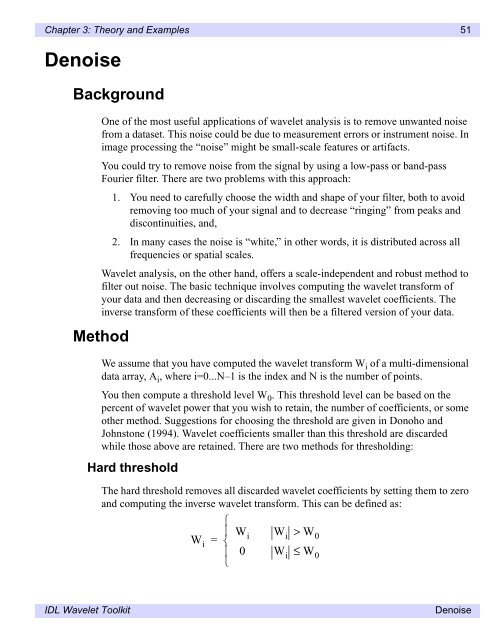IDL Wavelet Toolkit User's Guide
IDL Wavelet Toolkit User's Guide
IDL Wavelet Toolkit User's Guide
You also want an ePaper? Increase the reach of your titles
YUMPU automatically turns print PDFs into web optimized ePapers that Google loves.
Chapter 3: Theory and Examples 51DenoiseBackgroundOne of the most useful applications of wavelet analysis is to remove unwanted noisefrom a dataset. This noise could be due to measurement errors or instrument noise. Inimage processing the “noise” might be small-scale features or artifacts.You could try to remove noise from the signal by using a low-pass or band-passFourier filter. There are two problems with this approach:1. You need to carefully choose the width and shape of your filter, both to avoidremoving too much of your signal and to decrease “ringing” from peaks anddiscontinuities, and,2. In many cases the noise is “white,” in other words, it is distributed across allfrequencies or spatial scales.<strong>Wavelet</strong> analysis, on the other hand, offers a scale-independent and robust method tofilter out noise. The basic technique involves computing the wavelet transform ofyour data and then decreasing or discarding the smallest wavelet coefficients. Theinverse transform of these coefficients will then be a filtered version of your data.MethodWe assume that you have computed the wavelet transform W i of a multi-dimensionaldata array, A i , where i=0...N–1 is the index and N is the number of points.You then compute a threshold level W 0 . This threshold level can be based on thepercent of wavelet power that you wish to retain, the number of coefficients, or someother method. Suggestions for choosing the threshold are given in Donoho andJohnstone (1994). <strong>Wavelet</strong> coefficients smaller than this threshold are discardedwhile those above are retained. There are two methods for thresholding:Hard thresholdThe hard threshold removes all discarded wavelet coefficients by setting them to zeroand computing the inverse wavelet transform. This can be defined as:⎧⎪ WW i W i > W 0i= ⎨⎪ 0 W i≤ W 0⎩<strong>IDL</strong> <strong>Wavelet</strong> <strong>Toolkit</strong>Denoise
















